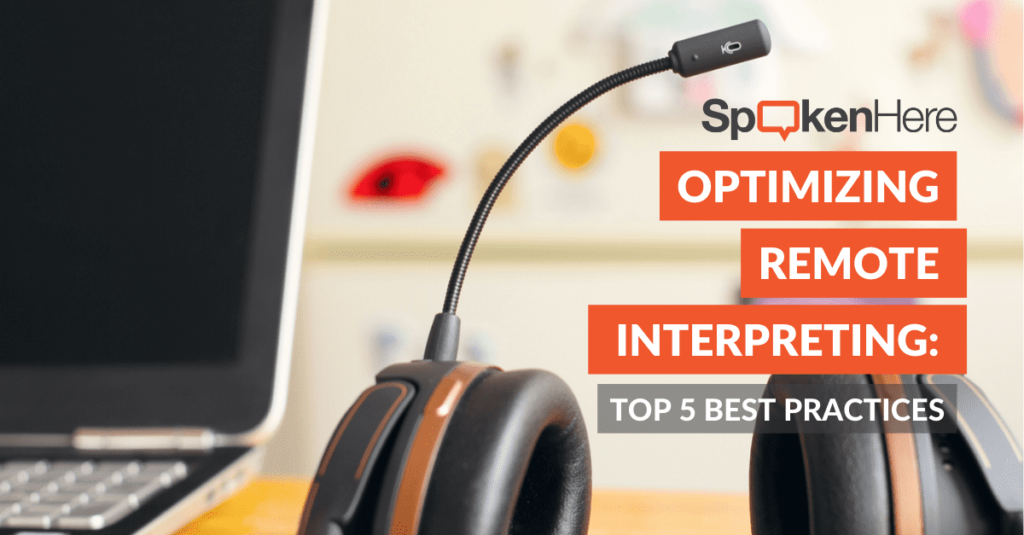Our team shares our favorite, proven strategies for preparing and then making the most of your over-the-phone or video remote interpreting session.
In today’s globalized world, effective communication knows no bounds. Whether overcoming linguistic obstacles or fostering trust in cross-cultural interactions, the role of professional interpreters is paramount. Remote interpreting, in particular, offers a seamless solution for facilitating meaningful conversations between parties with limited English proficiency (LEP) and those proficient in other languages.
Professional interpreters are adept at conveying ideas rather than simply relaying words verbatim. They navigate cultural nuances with finesse and refrain from injecting personal biases or opinions. This commitment to accuracy ensures that conversations are not only precise but also culturally correct (also called localization).

Here, we delve into our Top Five Best Practices for maximizing the efficacy of remote interpreting sessions.
1. Decide Which Style of Interpretation Session Fits Your Needs
Both over-the-phone and video remote interpretation sessions have pros and cons, and it’s important to decide which mode best fits your situation. When opting for remote interpreting, assess your needs and resources, and then select the most suitable option:
Audio Only (also known as OPI or over-the-phone interpreting)
- Ideal for situations requiring faster connection times
- Requires less equipment
- Available in more extensive language options
- Accessible 24/7, every day of the year, without an appointment
Video Remote Interpreting (also known as VRI or video remote interpreting)
- Requires a quality internet connection
- Offers visual cues and body language interpretation, enhancing comprehension and accuracy
- Availability is limited for some languages (8am-8pm EST with the exception of ASL and Spanish which are available 24/7)
- Important note: American Sign Language (ASL) necessitates a larger screen for optimal communication accuracy. ASL meetings should be conducted on the largest available screen. Avoid using anything smaller than an iPad or tablet.
2. Secure an Appropriate Location
Create an environment conducive to effective communication by:
- Ensuring privacy and minimal distractions.
- Providing adequate lighting to facilitate body language interpretation.
- Minimizing background noise to enhance audio clarity.

3. Check Equipment
Before either an over-the-phone or video remote session, verify that all technical aspects are in order:
- Test camera, microphone, and speakers to ensure functionality.
- Grant necessary permissions for our platform to access your camera, microphone, & speakers (this is usually only needed for first time connections, after major updates or with use of new/different equipment).
- Ensure a stable internet connection to avoid disruptions.
- Ensure you have adequate battery and/or have a charging device nearby.
Also, it is always a good idea to make a quick test call before your meeting, if you have not used our service before. This allowed you to troubleshoot any technical issues that may arise. You want to optimize your scheduled session by making sure that you don’t waste communication time.
4. Plan Ahead for Your Remote Interpreting Session
Be thoughtful as you prepare. Allocate sufficient time for interpreting sessions, as they typically require longer duration:
- A good rule is to double your expectation of how long a conversation will take. For example, 30-minute meetings or appointments should be scheduled for an hour to accommodate interpretation.
- Before initiating your conversation, provide the interpreter with a brief overview of the topic to be discussed. This will offer the interpreter valuable context, leading to a more efficient and cost-effective call.
- Always take your time in the conversation. Rushing can lead to errors, oversights, and discomfort for the LEP individual.
5. Speak Clearly
During a phone or video remote interpretation call, enhance clarity and comprehension for both parties by:
- Enunciating words clearly and avoiding slang or metaphors. Be aware of potential cultural factors and differences. What may be funny or meaningful for you in your native language could come across as offensive or meaningless for the other party.
- Pacing speech to allow for accurate interpretation. Pausing between sentences will allow the interpreter time to catch up and to convey your message accurately and completely.
- Addressing the other party directly while making eye contact rather than speaking to the interpreter or looking at the interpreter. For instance, instead of instructing the interpreter to convey a message like “Tell the other person that I am available for them anytime,” directly communicate to the other party by saying “I am available for you anytime” while directing your visual focus at the LEP individual.
- Allowing only one person to speak at a time. Remember that you are part of a conversation involving another individual and an interpreter. When multiple people speak simultaneously, the conversation can easily become chaotic. As the initiator of the interaction, take on the role of a moderator to ensure smooth progress.
Establishing Trust through Professional Remote Interpreters
Utilizing interpreters goes beyond mere translation of words; it fosters trust and lays the groundwork for enduring relationships and meaningful communication. Whether conducting remote business negotiations, medical consultations, or legal proceedings, leveraging professional interpreters ensures that every interaction is conducted with precision, empathy, and cultural sensitivity.
Do you want to learn more about our suggested best practices for over-the-phone or video remote interpreting? Our very own VP of Remote Services, Kim Beck, shares her tips for improving your experience when working with a remote interpreter, and she even adds a few additional fun notes! (Hint, hint…her most important tip is to remember not to be naked if you are on a video call 😉 ) Check out her video here:
Ready to chat with our team about how remote interpreting services could benefit your communications? Get started today with a free consultation!
